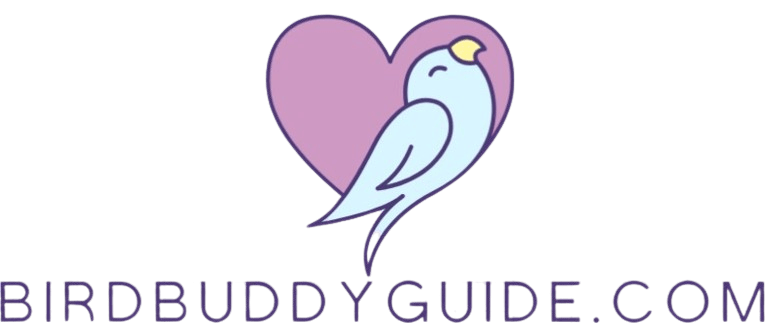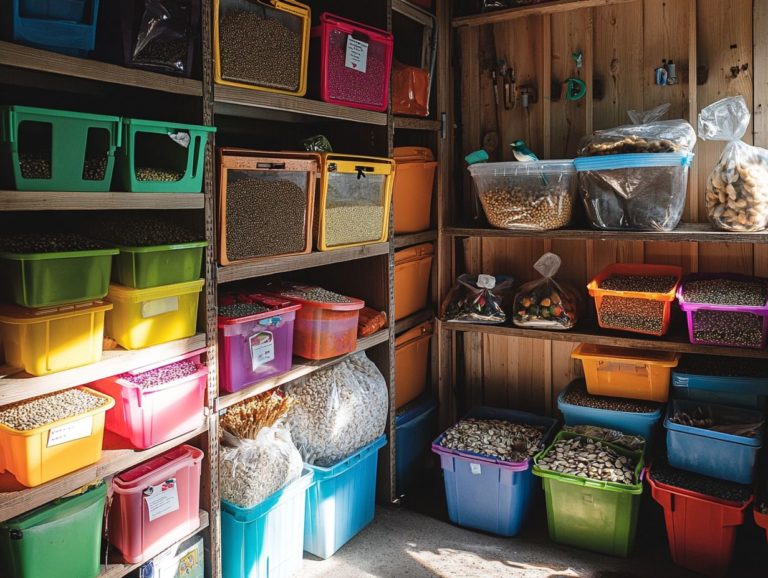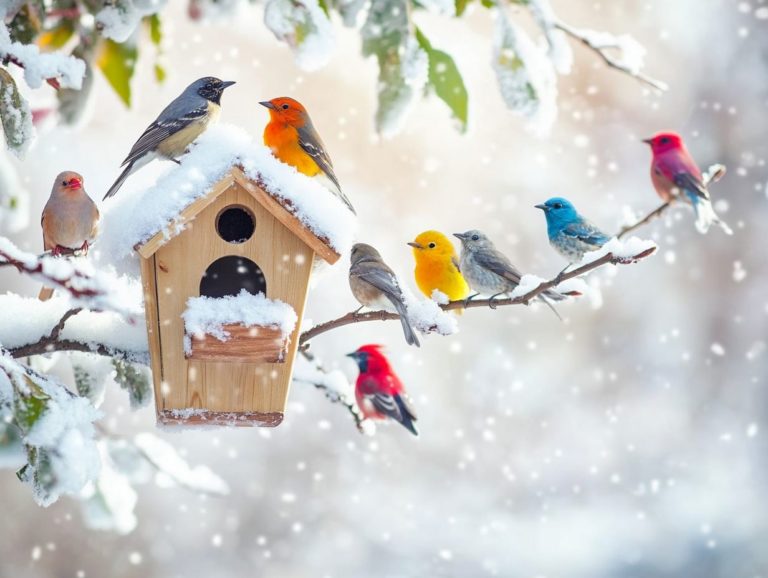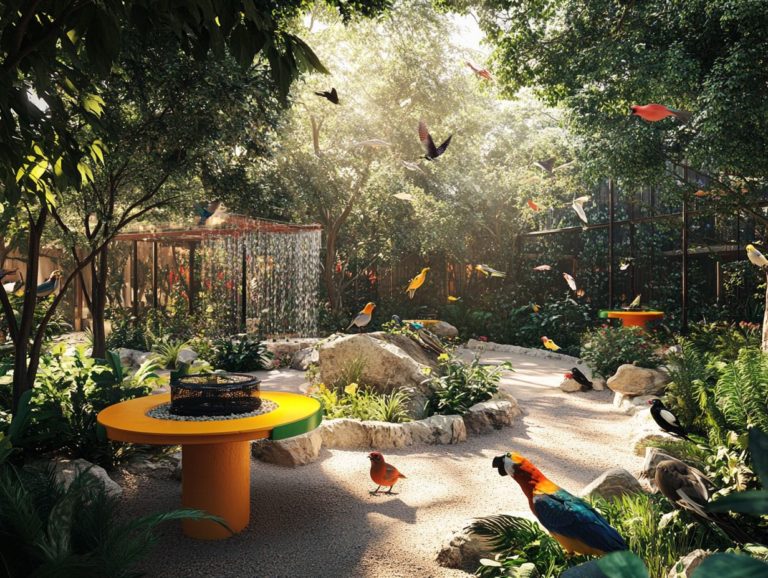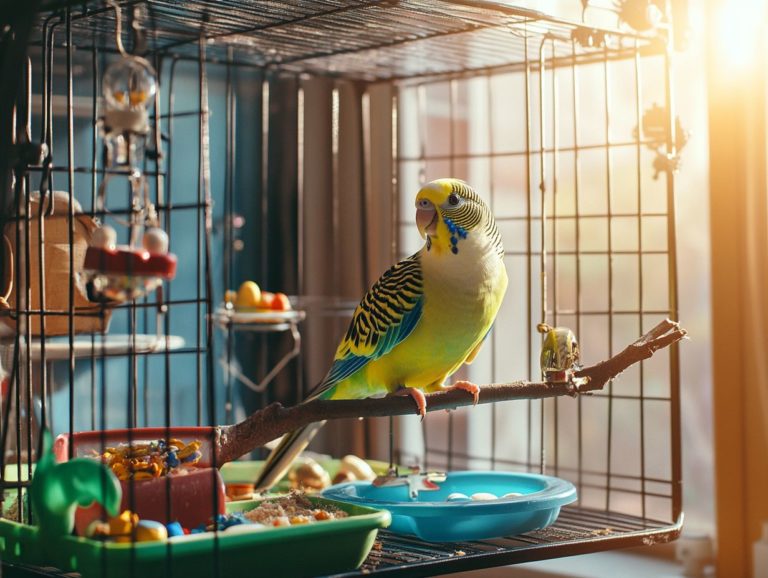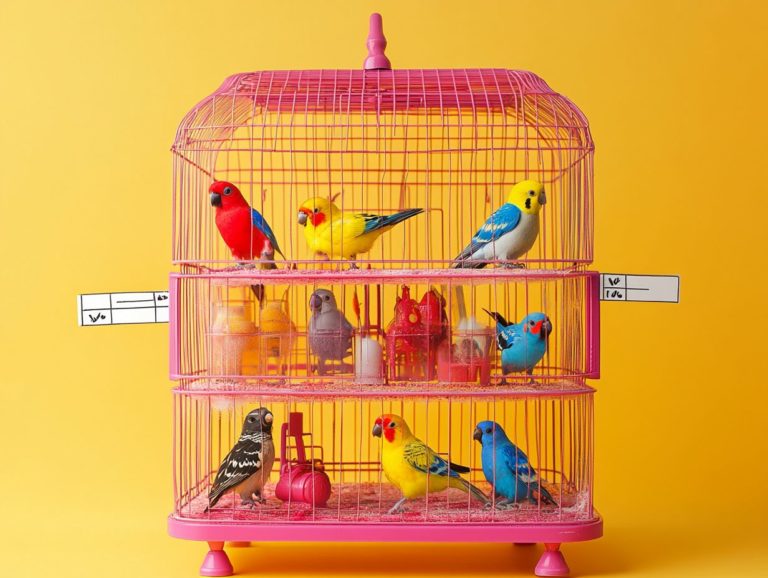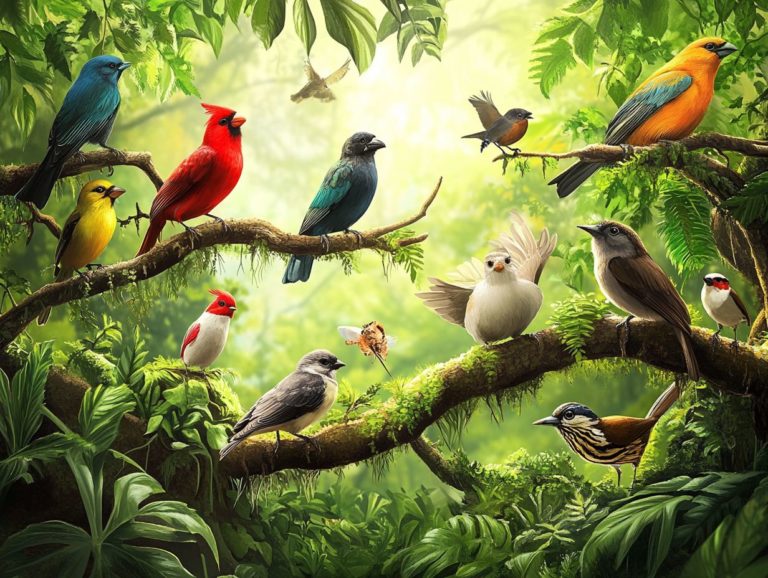Creating a Safe Outdoor Space for Your Bird
Creating a safe outdoor space for your bird is essential for their happiness and well-being.
Birds flourish in fresh air and natural sunlight. However, ensuring their safety in this environment requires thoughtful planning.
You ll need to understand the unique needs of different species while setting up a comfortable and stimulating area. There are several factors to consider in this process.
This guide will help you create the best outdoor experience for your feathered friends!
Contents
- Key Takeaways:
- Understanding Your Bird’s Needs
- Choosing the Right Outdoor Space
- Preparing the Outdoor Space
- Providing Enrichment and Stimulation
- Ensuring Safety and Security
- Monitoring Your Bird s Outdoor Time
- Frequently Asked Questions
- What is the importance of creating a safe outdoor space for my bird?
- What are some essential elements to consider when creating a safe outdoor space for my bird?
- How can I protect my bird from predators in the outdoor space?
- Are there any plants that are toxic to birds that I should avoid in my outdoor space?
- How can I provide enrichment for my bird in the outdoor space?
- Can I leave my bird unsupervised in the outdoor space?
Key Takeaways:
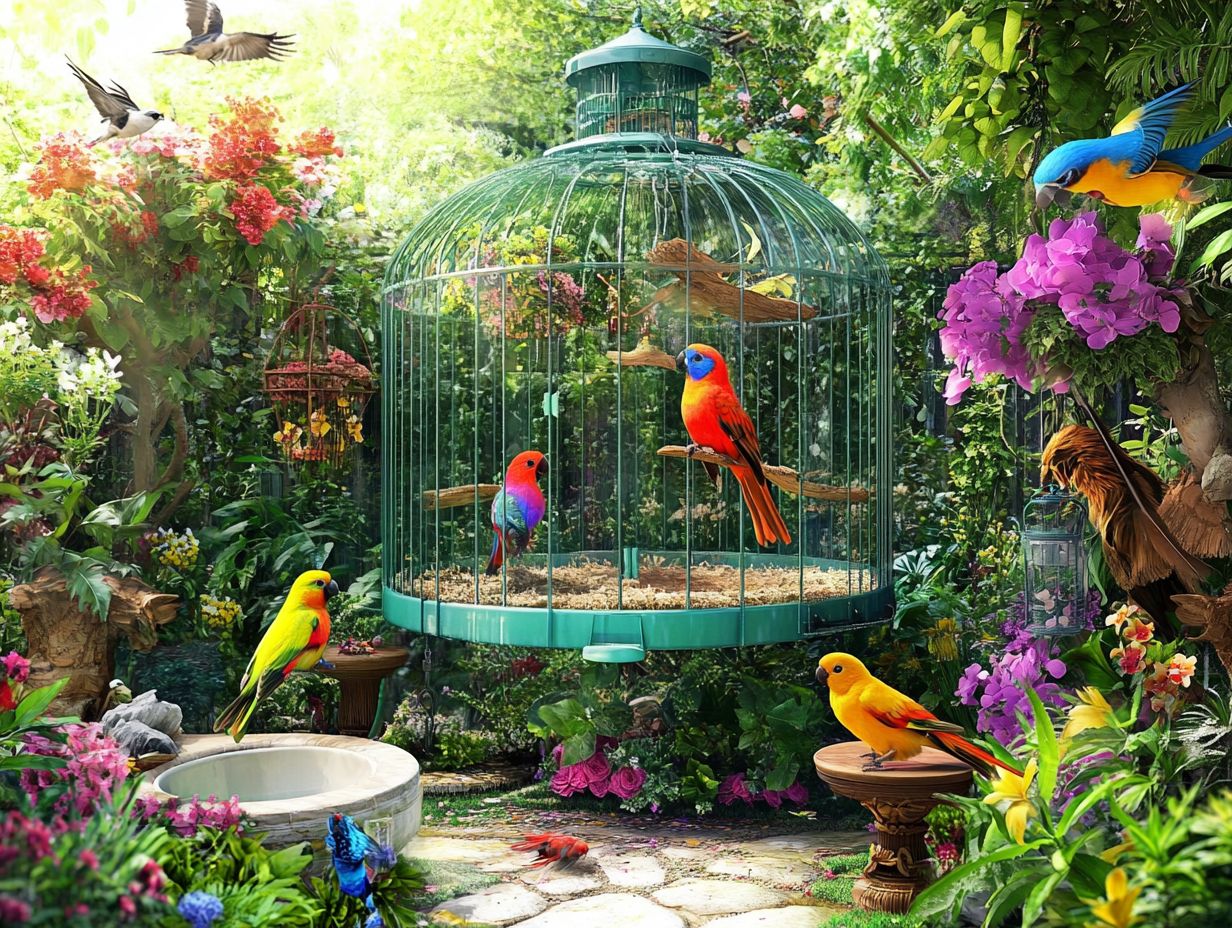
- Understand your bird’s specific needs and consider species-specific factors when creating a safe outdoor space.
- Choose a suitable outdoor space that prioritizes safety and comfort for your bird.
- Prepare the outdoor area by thoroughly cleaning and setting up enrichment and stimulation options for your bird’s enjoyment.
Get started on creating a bird-friendly paradise today!
Understanding Your Bird’s Needs
Understanding your bird’s needs is essential for crafting an optimal living environment. This not only bolsters their health but also encourages their natural behaviors.
Each bird species has distinct requirements that must be met, especially regarding their diet, shelter, and social interactions. With the loss of their natural homes and climate change, it’s crucial to create a habitat that closely resembles their natural surroundings.
This means providing a diverse array of food options, appropriate nesting sites, and avenues for migration, while also considering how to protect wildlife. By doing so, you cultivate a backyard sanctuary where local species can truly thrive.
Species-specific Considerations
When caring for birds, it’s essential to consider their species-specific requirements to ensure their well-being and overall happiness.
Different bird species have unique preferences when it comes to nesting sites, dietary needs, and migration habits, all of which you must take into account.
For example, local songbirds like the Eastern Bluebird flourish in open fields with access to fruit-bearing trees, while woodpeckers opt for dead or dying trees as their nesting sites. Hummingbirds thrive on a diet rich in nectar, making gardens filled with seasonally blooming flowers a vital resource for them.
By understanding these specific needs, you not only support their survival but also enhance your backyard habitat, attracting a diverse array of bird populations and fostering healthier ecosystems.
Choosing the Right Outdoor Space
Choosing the right space for your birds is crucial. It should be safe, inviting, and encourage their natural behaviors.
This space should incorporate bird-friendly features like clean feeders, a dependable water source, and sheltered areas that protect against predators and harsh weather.
By making your outdoor environment welcoming to birds, you enhance their experience, promote their well-being, and attract a diverse range of species.
Thoughtfully choosing the location and elements of your bird-friendly habitat can significantly boost biodiversity in your area.
Factors to Consider for Safety and Comfort
When selecting an outdoor space for your birds, prioritize safety and comfort above all else; these considerations will shape your choices significantly, especially when learning how to create a safe space for your adopted bird.
Creating an environment that shields them from potential predators is crucial. This alleviates stress and encourages more natural behaviors.
Regularly cleaning feeders is essential to prevent the spread of diseases, ensuring a healthier feeding area for the local avian community. Providing a reliable water source is important as it quenches their thirst and offers them the opportunity to bathe, which is vital for maintaining their feathers.
By addressing these key factors, you can play a significant role in combating habitat loss. This fosters a thriving ecosystem that benefits both your backyard birds and the broader environment.
Preparing the Outdoor Space
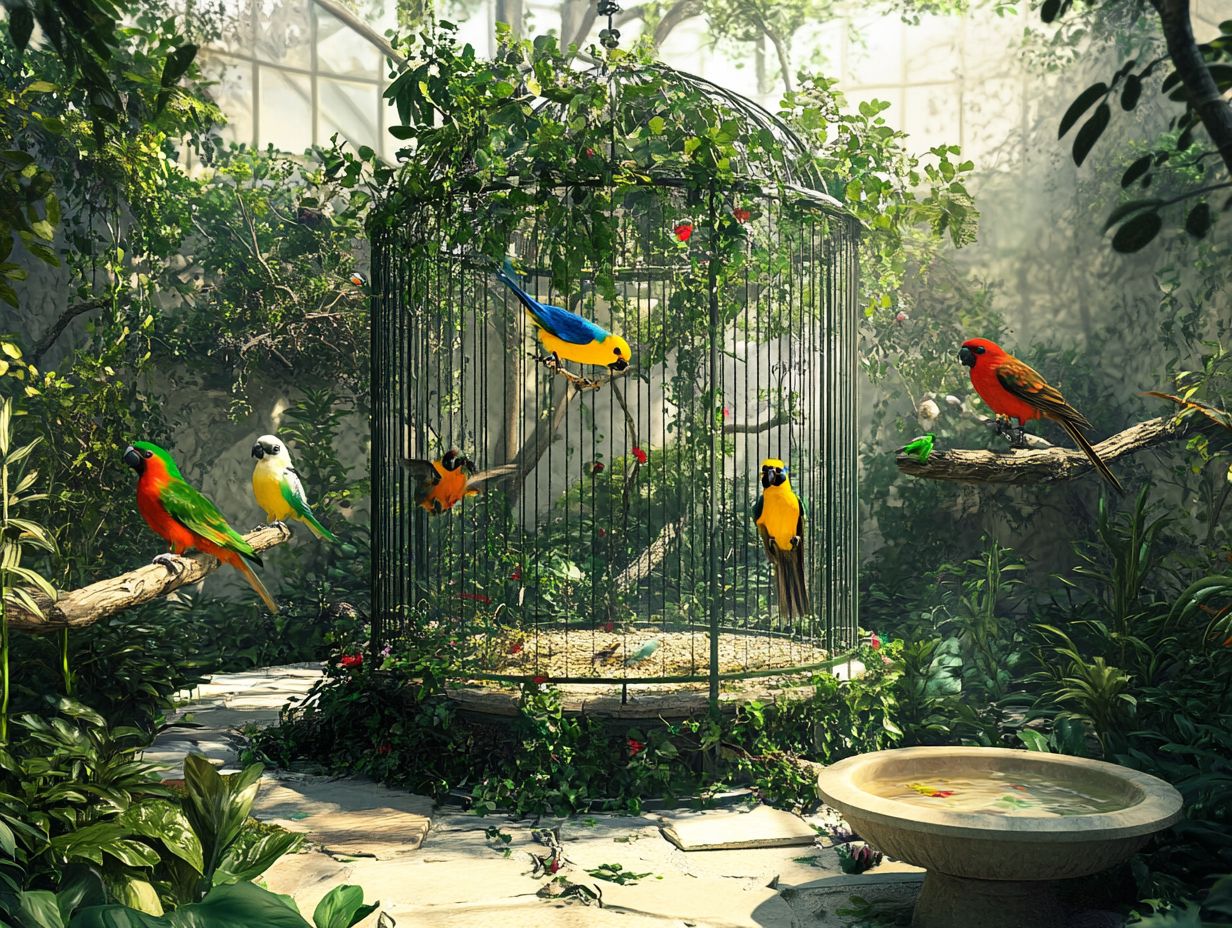
Preparing your outdoor space for birds requires careful planning, especially if you want to know how to create a bird play area outside. This helps create an environment that promotes their health and happiness.
Incorporating native plants attracts local species and enhances biodiversity. It’s also important to ensure the area is free from invasive plants. Native plants provide essential food sources and habitat layers for various wildlife.
Following planting rules, along with implementing weed control and natural pest management strategies, maintains a thriving ecosystem tailored to your feathered companions.
Cleaning and Setting Up the Area
Cleaning and setting up the area for your birds is essential for creating a healthy and inviting sanctuary in your backyard. For detailed tips, check out this guide on how to prepare your home for a new bird.
Keeping the area clean helps prevent diseases that could harm your birds. It also encourages them to visit more often.
Regularly sanitizing bird feeders and water features eliminates mold, bacteria, and harmful pests that might deter wildlife. Ensuring that bird shelters are tidy provides a safe haven for birds to rest and nest.
It’s also crucial to arrange these elements strategically. Consider factors like proximity to natural shelter and easy access to food and water. These factors contribute significantly to fostering a thriving avian community.
Providing Enrichment and Stimulation
Providing enrichment and stimulation for your birds is crucial for their mental and physical well-being. This helps them stay active and engaged with their environment, particularly by considering their migration patterns.
Incorporating a variety of activities and toys mimics their natural behaviors while enhancing biodiversity in your backyard sanctuary. This attracts a diverse array of species.
Engaging local wildlife, including pollinators and other creatures, adds an enriching layer of interaction. This benefits both your birds and the surrounding ecosystem, creating a vibrant tapestry of life in your space.
Activities and Toys for Your Bird
Incorporating engaging activities and suitable toys for your bird is essential for maintaining their mental stimulation and overall happiness.
Every bird species has unique needs, making it crucial to select items that cater to those characteristics. For instance, parrots thrive with foraging toys that mimic their natural quest for food. In contrast, smaller finches may enjoy simple swings or mirrors.
Providing nesting materials like shredded paper or soft grass nurtures healthy nesting instincts. A thoughtfully curated combination of toys and activities keeps your birds entertained and enhances their well-being and social interactions.
Ensuring Safety and Security
Ensuring the safety and security of your birds outdoors requires your vigilance and proactive measures against potential hazards, including knowing how to set up a safe play area for my bird.
Staying alert and taking thoughtful steps creates a secure environment for your feathered friends.
Precautions to Take and Potential Hazards to Watch Out For
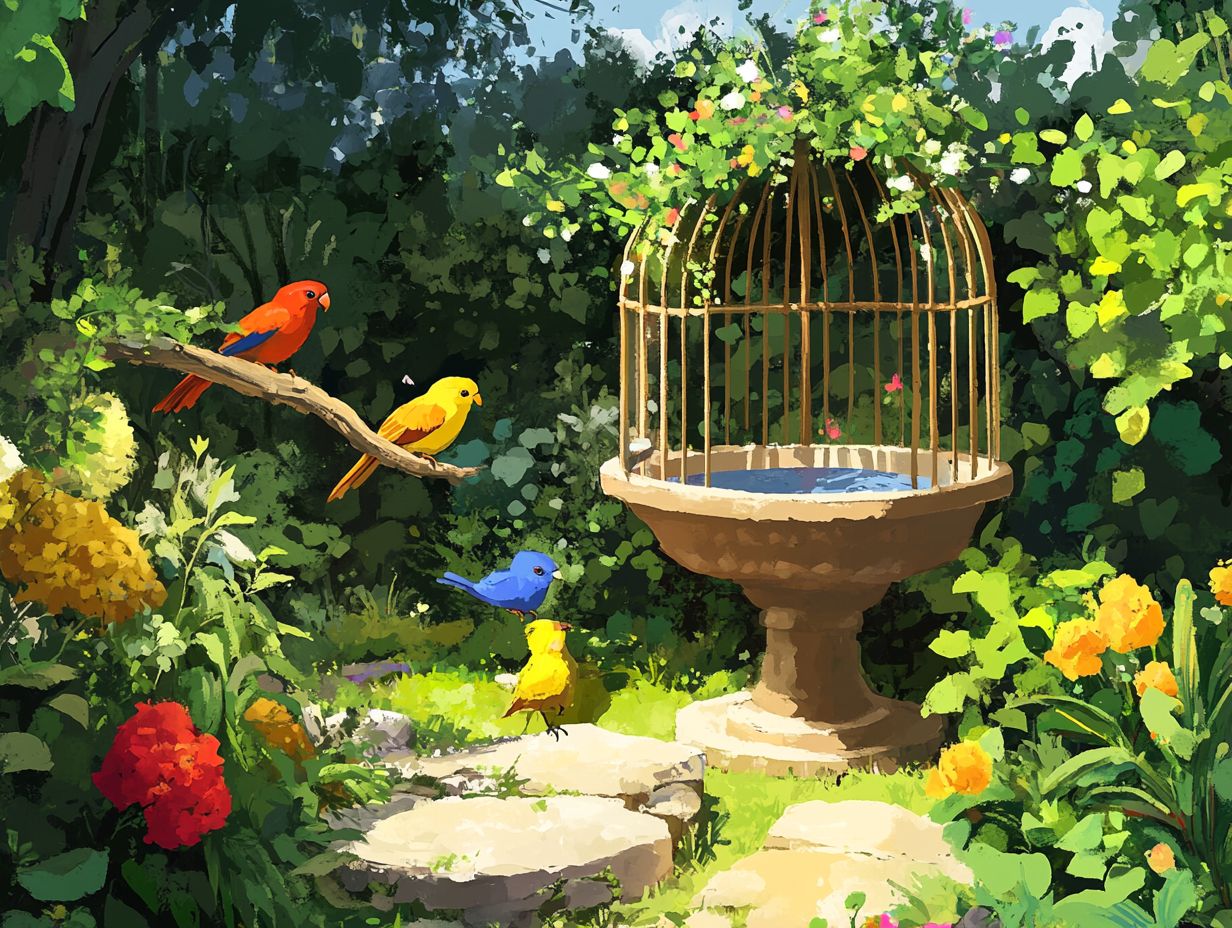
To safeguard wildlife, recognize the potential hazards that could jeopardize your birds’ well-being outdoors, including threats from climate change.
These dangers may include predators like cats or hawks and environmental risks such as toxic plants or contaminated water sources.
Climate change can threaten their habitats through extreme weather.
To counter these threats, create safe, sheltered spaces for birds to find refuge. Consider setting up a training area for your bird to help them feel secure. Regularly inspect their surroundings for emerging dangers. By taking these precautions, you reduce risks and enhance the health and vitality of these feathered friends.
Ultimately, this ensures they thrive in a safer outdoor environment.
Monitoring Your Bird s Outdoor Time
Monitoring your bird s outdoor time is essential for their well-being, as it enables you to spot any signs of stress or illness that might emerge while they enjoy the fresh air. By watching for any changes in behavior, you can ensure they feel comfortable and happy in their outdoor surroundings.
Watch how your bird interacts with local wildlife, as these encounters can enrich their experience, but it’s essential to make sure they remain stress-free.
Signs of Stress or Illness to Look Out For
Recognizing the signs of stress or illness in your birds is essential for ensuring prompt care and safeguarding wildlife. Birds often display various signs that suggest they may be unwell or stressed. Keep an eye out for changes in behavior like increased vocalization, lethargy, or isolating themselves from their flock as these are key signals.
A decline in feeding habits, such as turning their beaks up at favorite foods or eating less than usual, can also be a sign of distress. Physically, you should be alert for symptoms like fluffed feathers, abnormal droppings, or difficulty breathing.
If you see any of these signs, act quickly and consult an avian veterinarian (a veterinarian who specializes in birds). To keep your bird safe outdoors, create a safe environment with secure shelters, clean water, and a balanced diet to support their well-being.
Frequently Asked Questions
What is the importance of creating a safe outdoor space for my bird?
A safe outdoor space keeps your bird happy and healthy! It allows them to experience natural sunlight, fresh air, and engage in natural behaviors, especially when you focus on creating a safe play area for your bird.
What are some essential elements to consider when creating a safe outdoor space for my bird?
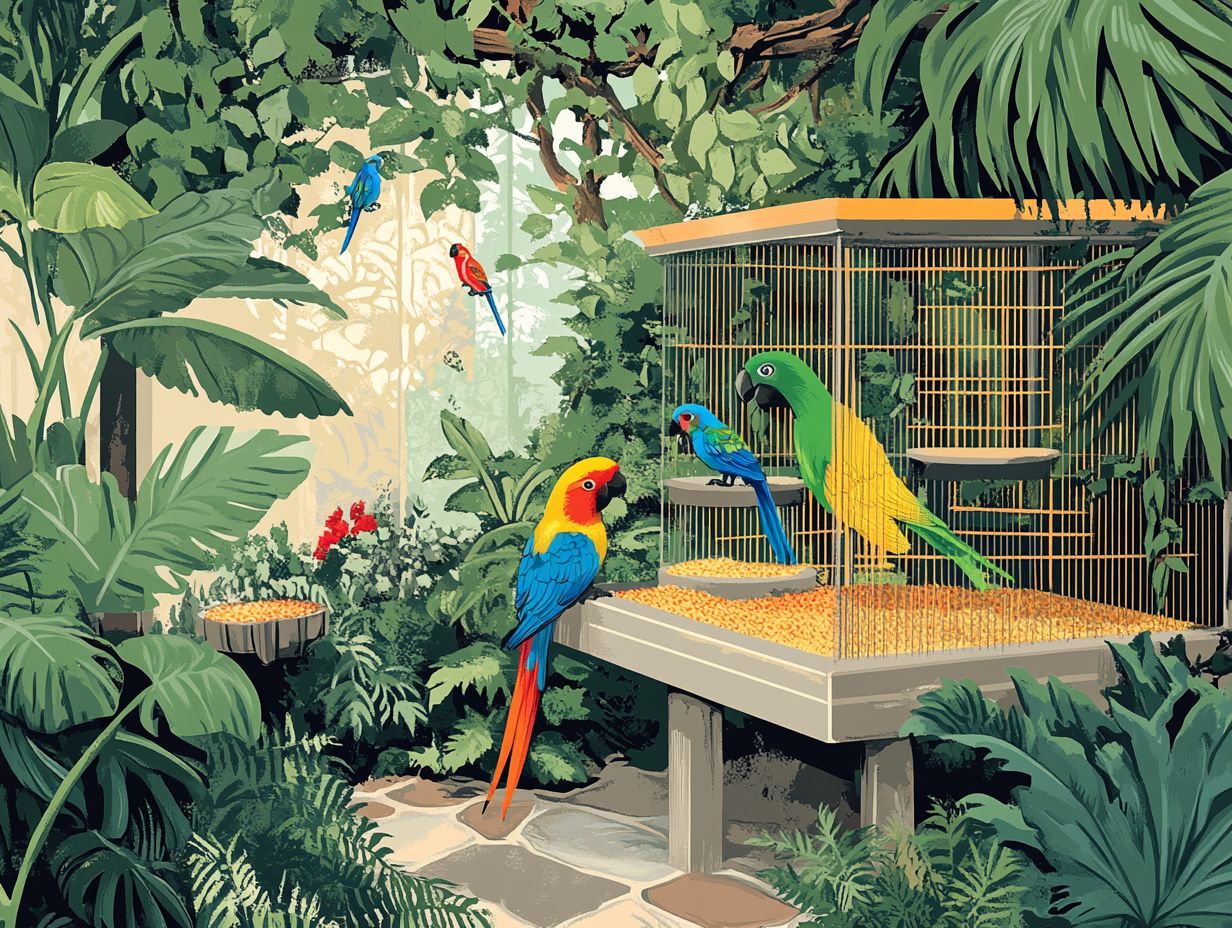
Some essential elements include providing adequate shelter and shade, using safe and non-toxic materials, ensuring proper ventilation, and protecting against predators.
How can I protect my bird from predators in the outdoor space?
You can use bird netting, outdoor aviaries, or secure fencing to protect your bird from predators. Additionally, learning how to create a calming environment for birds is crucial. Always keep an eye on your bird to ensure they are safe.
Are there any plants that are toxic to birds that I should avoid in my outdoor space?
Yes, many plants are toxic to birds, including avocado, daffodils, lilies, and tulips. It s important to research and avoid these plants in your outdoor space.
How can I provide enrichment for my bird in the outdoor space?
You can provide various natural perches, bird-safe toys, and opportunities for foraging to keep your bird mentally stimulated outside. Additionally, creating a stress-free environment for birds by rotating their outdoor space with different toys or perches can prevent boredom.
Can I leave my bird unsupervised in the outdoor space?
No, it is not recommended to leave your bird unsupervised outdoors. Even with precautions, there is always a risk of predators or other dangers. Always supervise your bird while they are outside.
